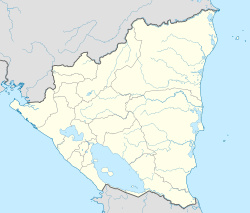Rosita, Nicaragua facts for kids
Quick facts for kids
Rosita
|
|
|---|---|
|
Municipality
|
|

Rosita and Bonanza Mine and town complex in the late 1950s
|
|
| Country | |
| Department | North Caribbean Autonomous Region |
| Area | |
| • Municipality | 851 sq mi (2,205 km2) |
| Elevation | 190 ft (58 m) |
| Population
(2022 estimate)
|
|
| • Municipality | 38,629 |
| • Density | 45.374/sq mi (17.519/km2) |
| • Urban | 16,193 |
| Time zone | UTC-6 (Central Time) |
| • Summer (DST) | UTC-6 (No DST) |
| Climate | Af |
Rosita is a town and a municipality in the North Caribbean Autonomous Region of Nicaragua. A municipality is like a local government area. Rosita is an important place in this part of Nicaragua.
Contents
Discovering Rosita's Location
Rosita is located in the eastern part of Nicaragua. It is part of the North Caribbean Autonomous Region. This area is known for its unique culture and nature.
Where is Rosita on the Map?
The town of Rosita is about 480 kilometers (around 300 miles) from Managua. Managua is the capital city of Nicaragua. Rosita shares its borders with several other municipalities. To the north is Waspán. To the south are Prinzapolka and Bonanza. To the east, you'll find Puerto Cabezas and Prinzapolka. Finally, to the west is Siuna.
Rosita's Past: A Mining Town's Story
Rosita, once called Santa Rita, started growing in the 1940s. This was when a company called the Rosario Mining Company began mining there. They were looking for valuable minerals.
The Rise and Fall of Copper Mining
Between 1951 and 1955, explorers found a lot of copper ore. This led to a big copper mining operation. However, in 1975, the price of copper dropped. Because of this, the mining stopped. In 1979, the mine became owned by the government. By 1982, it was completely taken apart and abandoned.
Becoming Its Own Municipality
Rosita used to be part of the Prinzapolka municipality until 1971. But in 1989, Rosita became its own separate municipality. This meant it could have its own local government. In 2005, Rosita was officially given the title of a city.
Who Lives in Rosita?
As of 2022, Rosita has about 38,629 people living there. Slightly more than half of the people are men (51.6%), and a little less than half are women (48.4%). About 41.9% of the people live in the main town area. The rest live in the countryside.
Rosita's Environment and Weather
Rosita has a very humid subtropical climate. This means it gets a lot of rain. The area receives between 1900 and 3290 millimeters (about 75 to 130 inches) of rain each year. This wet climate helps the plants and trees grow.
Communities in Rosita
The main town of Rosita is divided into 11 neighborhoods. Outside the town, there are 81 smaller communities in the rural areas. These communities are home to many different groups of people.
How People Make a Living in Rosita
The main way people earn money in Rosita is through farming. However, the soil in the area is not very good for growing crops. This makes it hard for people to find work. Because of this, about 80% of the people in Rosita do not have jobs.
Rosita's Rich Culture
Rosita is a place where many different groups of people live together. These include the Sumos, Miskitos, Creoles, and Mestizos. Each group has its own special traditions and celebrations.
Traditional Foods and Festivities
Many of the cultural festivals are held in the rural communities. People celebrate their ancestors' customs. Some typical foods include "wabul," made from bananas, cassava, or a root called quequisque. Another traditional food is "buña," which is made with pejibaye, cassava, and fruits that are in season.
Getting Around Rosita
Rosita is located on the main highway that connects western Nicaragua to Puerto Cabezas. Puerto Cabezas is a city on the Caribbean Sea.
Rosita's Airport
Rosita also has a small airport called Rosita Airport. Its airport code is RFS. However, this airport does not have regular flights.
Images for kids
See also
 In Spanish: Rosita (Nicaragua) para niños
In Spanish: Rosita (Nicaragua) para niños




